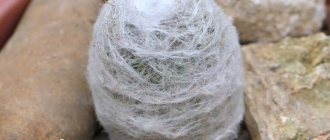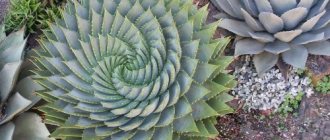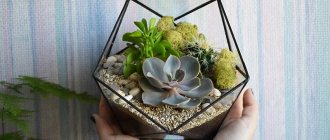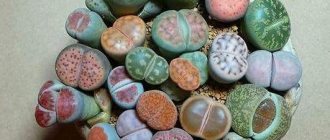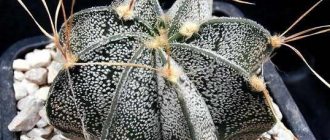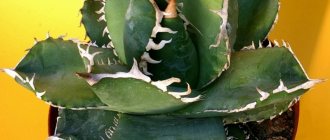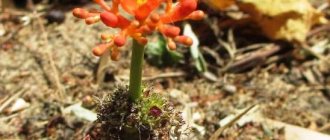Succulents are unpretentious plants native to hot and arid countries. Many plant growers keep undemanding exotic plants in their homes. Caring for succulents is quite simple; you need to follow watering schedules, monitor the temperature and lighting. Also, beginning gardeners need to know how to replant succulents at home correctly.
How to transplant succulents after purchase
If a new flower from the store appears in the house, it should definitely be replanted. Crops are often sold in containers with special transport or regular soil, which is not suitable for long-term cultivation. The flower should be placed in new soil within the first week after purchase. If the soil in the temporary container is dry, you can replant it immediately. The wet soil is allowed to dry for several days, which will also be useful for the plant’s adaptation to new conditions. Special soil for transplanting succulents is sold in specialized flower shops. To improve drainage properties, the substrate is mixed with a small amount of river sand.
Photo of the moment of transplanting the purchased succulent into a new pot
When preparing soil for succulents, the following components are used independently: soil, sand, peat (can be replaced with humus). They are mixed in a ratio of 1:2:1. If the cactus variety is more moisture-loving, one part of the sand is replaced with soil. The resulting soil mixture must be loose; in hard, lumpy soil it will be difficult for the flower to develop.
The presence of a drainage layer is also important. It is placed on the bottom of the container, in a layer of about 2 cm
Drainage allows you to remove excess water from the ground, normalize microflora, and prevents moisture retention in the rhizome and its rotting.
It is worth noting that for planting succulents, soil, sand and materials chosen for drainage (for example, rock chips, pebbles, etc.) must be disinfected. To do this, bulk materials are calcined in the oven, the pebbles are thoroughly washed, and soaked for some time in a light solution of manganese. An undisinfected soil mixture can cause the development of pathogenic bacteria and the spread of various diseases among exotic representatives of the flora.
After preparing the necessary materials, the succulents are actually transplanted. When replanting cacti, get thick gloves in advance. Foam rubber will also come to the rescue. With the help of its dense small pieces, you can move the crop without pricking your hands. Using foam rubber helps not to harm the crown and keeps all the existing thorns in place.
How to regularly replant succulents
Transplantation is carried out in two ways. The first is the transfer method, when the plant is placed in a new container with a lump of soil in which it grew before. This option is gentle and allows less damage to the roots. The second method involves completely clearing the rhizome from the soil and removing its damaged parts. The roots are cleaned using a sharp knife; the sections must be treated with an antiseptic. If the soil is sticky and makes dry cleaning of the rhizome difficult, it is recommended to soak it under running water or place the succulent in a bath of water for a while. After cleaning the rhizome, you should give it time to dry thoroughly. The prepared culture is planted in a container.
During replanting, you should inspect the roots of the plant for any signs of pests or rot. Don't be afraid to trim the roots - it's useful and stimulates their growth. The planting steps look like this:
- Selecting a pot, laying a drainage layer (1-2 cm) on its bottom.
- Filling with prepared soil mixture.
- Planting a seedling, filling its roots with the remaining soil mixture. You need to fill it up so that the neck connecting the lower and upper parts of the crop is visible. The soil mixture is lightly compacted.
- Filling the top layer with rock chips.
How to properly replant succulents
Watering should be stopped 7–8 days before transplanting. It is best to start work in clear weather.
The transplant includes several stages:
- Carefully remove the plant from the pot, avoiding any tension. To better separate the soil from the walls and bottom of the pot, you need to knock on them first. If the pot is plastic, then the walls can be squeezed.
- Lightly shake the earth ball, getting rid of the remaining substrate. Then the root system is cleaned with a brush. Scissors remove diseased, damaged and dry roots. The sections are treated with crushed charcoal. If white spots are noticeable on the roots, which indicates the presence of pests, then you need to treat the plant with an insecticide.
- Drainage is placed at the bottom of the pot (you can use gravel, crushed stone, brick chips, expanded clay, vesiculite, foam) to prevent moisture stagnation.
- Fill some soil over the drainage and install the plant, straightening the roots. Then fill the entire space with soil, compacting it. A centimeter layer of sand is poured on top of the substrate.
- The soil is slightly moistened. Water the flower only every other week. You can fertilize no earlier than a month later.
Large plants are replanted using the transshipment method - with a lump of earth.
Money tree as a talisman to attract money
According to the recommendations of Feng Shui experts, planting a money tree provides people with financial success and well-being. There are many signs and superstitions associated with the plant.
It is advisable to pay attention to the following:
- To make a profit, it is recommended to communicate with a fat woman. The best day of the week is Wednesday. They tell the money tree about financial problems and ask it for help and success. They do it with soul.
- When wiping the leaves, it is recommended to count them. Each leaf symbolizes a coin, and money, as you know, loves counting.
- For planting, choose a red pot. If this is not the case, then the problem is solved in another way - they tie it with a red ribbon or apply patterns on it with red paint.
- After the profit has appeared, a few coins are placed in a pile near the pot. This enhances the effect of the money tree as a talisman.
Note! Often the appearance of a money tree in the house helps solve many problems. It is recommended to follow the rules for caring for the plant
Particular prosperity in the house is expected when the money tree blooms. At home, this rarely happens, so the appearance of flowers on a plant is a favorable sign.
A money tree can even be grown from a leaf.
If the pot suddenly fell and broke, this is not a negative sign. The phenomenon suggests that material well-being, on the contrary, will improve. In this case, envious people may appear.
It is important to provide a good place in the interior for the flower. There should be no bright or contrasting colors in the room
What's so attractive about succulents?
How to replant succulents at home: we understand the nuances of care
Succulent garden
The name succulents, translated from Latin as “succulent”, was given to these plants due to their ability to store moisture for future use in their trunks and leaves. Therefore, they do not require special care and do not require frequent watering.
The variety of succulents is impressive. Tiny that can be grown in test tubes, and impressive in size, they look good in a home conservatory or just on a windowsill. Succulents stand out for their bizarre shape, surprising with the unexpected color of their leaves and unusual flowering.
It is believed that an indoor succulent shares useful energy with a person. It is no coincidence that they are recommended to be placed near a computer monitor; they have a beneficial effect on humans, some types have a healing effect.
Many people remember aloe; this is one of the varieties of succulents that our grandmothers considered mandatory to have on the windowsill. It is recommended to have a fat tree or “money tree” in your apartment or office to ensure financial well-being.
Some of the most popular succulents are also “living stone” and sedum, agave and various types of crassula, milkweed, echeveria and many other flowers.
Read more about Indoor succulents - varieties, care features
Let's find out in more detail how exotic indoor succulents are bred using leaves, plant cuttings or its seeds.
How to use coconut substrate?
Few people know how to properly use this product and plant plants in it. If you choose a substrate in the form of briquettes, they must first be soaked. This is done simply: the material is placed in a deep container and filled with warm or hot water. During the work, as it is absorbed, the liquid is gradually added.
The substrate will begin to increase in size and fall apart. A briquette weighing 1 kilogram will yield about 6 kilograms of soil, ready for planting. Some experts advise rinsing the product with high-temperature running water after swelling. To do this, the substrate is covered with gauze; nylon products can also be used.
The moistened substrate is sent to a container with drainage lined at the bottom, after which the plant is planted in it. Then the mixture needs to be fertilized. Compositions containing nitrogen are best suited for this. They also use special complex formulations intended for plants of various varieties.
Subtleties of transplantation
When replanting a fat plant after pruning, it is best to choose a shallow and wide container for this, taking into account the characteristics of the plant’s root system. In order for the Crassula to stand steadily, the width of the pot must correspond to the size of the crown. A narrow, high pot can completely stop the growth of a tree. Therefore, it is necessary to replant the money tree into a wide flat container not only after pruning, but also if it is not growing well. A heavy ceramic pot is ideal.
Replanting can be done quite often, even once every six months, by transferring the plant along with a lump of earth from one container to another and adding new soil on top. Transferring it to a wide pot will speed up the growth of the plant and make it more beautiful and healthy. You should not break off the leaves at the bottom of the trunk; they will fall off on their own over time, and until then they will serve as feed for it.
A layer of expanded clay should be placed at the bottom of the pot, and a mixture for cacti and succulents should be used as soil. You can prepare the soil yourself: mix coarse sand, leaf and turf soil in equal proportions, adding half a portion of peat to them. It is best to place the plant on the southeast side of the apartment, which can be determined by using a compass.
Since the money tree is constantly reaching for the light, you will have to regularly turn the pot so that the branches and trunk of the plant do not bend. You should also protect it from cats, who for some reason love to rub their faces and backs against it, after which the leaves simply fly off and fall off. Otherwise, caring for the plant is not difficult.
The technology of filling the pot has its own characteristics.
- Up to a third of the container can be occupied by the lowest drainage layer - pebbles for water outflow. They are disinfected with potassium permanganate and dried well.
- Next comes the soil mixture. It’s more convenient to use a ready-made one from the store. It is quite difficult to prepare a mixture for succulents yourself, since this word implies many varieties. For some of them, the nutritional value of the soil is important, for others it can even be harmful. The easiest option is to mix cleaned turf and nutrient soil. It is better to take it under the leaves, clearing it of grass, debris and roots. To prevent such soil from clumping, sand, peat, charcoal, and small stones are added to it. All components must be disinfected by keeping them in the oven. Coconut substrate deserves special attention. It can be used in its pure form or mixed with soil in a one to one ratio. Such soil will be moderately nutritious, loose, with good air exchange. The pressed substrate is pre-soaked, dried and only then laid as soil. Otherwise, you may make a mistake in the volume.
- You can scatter sand or drainage pebbles on top around the plant.
How to grow succulents correctly
Many stem succulents have spines or thorns. To protect yourself from them, purchase thick rubber gloves in advance and stock up on foam rubber to hold the flower when moving. The plant itself should also be prepared. Watering must be stopped in advance so that the existing soil in the pot is completely dry.
Characteristics and use of hydrogel
Relatively recently, hydrogel appeared in floriculture stores.
This product immediately attracted the attention of buyers due to its amazing appearance. The product may be sold in the form of granules, powder or crystals
It is able to absorb and retain moisture. When wet, the elements increase significantly in size. Manufacturers have added safe dyes to their composition, thanks to which the granules are full of a variety of colors.
Larger hydrogels are used as a substitute for substrates and soils for houseplants. Plants are planted in transparent containers, creating amazing living compositions. The fine product is mixed with soil. This composition is often used for germinating seeds.
Often the product acts as a decorative addition to the interior. By mixing several bright colors in one transparent container, you can add color and expressiveness to your decor. Such an element will become an accent and complement the style.
Why is a transplant needed?
There are several reasons to repot succulents.
- Prevention after purchase. When purchasing a plant from hand or in a store, you can never be sure of the correct planting and the quality of the soil. Therefore, it is better to carry out this procedure yourself.
- Diseases. If any damage is detected, the first thing to do is to inspect both the plant itself and its roots. And then begin treatment by placing it in new soil.
- Inconsistency between the size of the plant and the pot. Moreover, this applies not only to the roots, but also to the trunk with leaves. In the first case, crowding can cause poor growth. In the second, the above-ground part can simply outweigh the pot.
- Poor soil condition. If the contents of the pot are compressed and form a dense lump through which water cannot seep, it needs to be replaced. Often in such cases a gap forms around the perimeter of the pot.
- Accidents. Pots rarely fall. In this case, it is better to carry out the entire transplantation procedure again and not try to eliminate only external traces of the fall. It is quite possible to reanimate a broken part of a succulent.
Step by Step Actions
Having prepared everything you need, you can begin transplanting.
- First, you need to remove the flower from the old pot. To do this, you can lightly tap on the bottom and walls. If this doesn't work, try making gaps around the perimeter of the pot.
- When you remove a succulent, you must inspect the condition of the roots. And to do this, you need to destroy the earthen lump - completely (for a young plant) or partially (if the plant is already an adult). It is better to remove soil in a dry state. If damage is found, they need to be cut off and the remaining roots washed with potassium permanganate. Be sure to dry the wet roots and only then proceed with further actions.
- Place pebbles and a couple of centimeters of soil at the bottom of the pot. We try on the plant so that the line where the root growth ends is a centimeter below the edge of the pot.
- Then we begin to slowly add soil, trying to add it evenly on all sides. The pot must be shaken slightly so that the internal contents are distributed more evenly. If there is only one plant, we place it in the center. If there are several of them, it is better to separate the roots with plastic partitions. Before planning a group planting, be sure to check their compatibility information.
For stability and protection from drying out, pebbles are placed on the surface. The distribution of the soil should be such that there is a little space left on top for water and it does not overflow when watering.
Options for growing succulents
To answer the question of how to plant succulents, you first need to become familiar with their reproduction processes. There are several options. Plants can be propagated using cuttings, leaves and seeds. If you follow all the recommendations from experts, then any of this methods will be effective, and a new representative of your home flora will quickly appear on the windowsill. And over time, you will even have to think about how to replant succulents.
Propagation by leaves is only suitable for those types of succulents in which they are thick and fleshy. For varieties with thin leaves, propagation by cuttings is used.
First of all, you need to properly prepare the planting material. To do this you need:
- Choose a completely healthy leaf or cutting.
- Take a sharp knife and wipe it with a disinfectant.
- Cut off the leaf/cutting at the very base.
Note! There is no need to immediately plant the taken shoot in the ground or put it in water. It should lie down for about 2 days and dry out a little.
If juice is released from the cutting, it should be washed off with filtered water, and then the cut area should be sprinkled with crushed activated carbon. Then the cutting can be germinated in water, but you just need to make sure that it does not touch the bottom of the container. You can also germinate planting material in fine-grained sand. To do this, the cuttings are planted no deeper than 2 cm and are well fixed with fine gravel. The planted plant must be watered.
The germination process will be successful if the room maintains a stable temperature of about 23-25 °C. The root remedy will also benefit the plant.
Kornevin - growth accelerator
The leaf is rooted a little differently. For it you need to prepare well-disinfected soil. For this, either sand or a special substrate purchased in a store, to which sand or fine-grained expanded clay is added, is suitable. There is no need to plant the leaf in the ground; it is placed on dry soil at an angle so that it is convenient for it to take root.
Next, the shoot needs proper care.
- There is no need to water the leaf; it must be sprayed periodically.
- The pot is placed in a bright place, but drafts and direct sunlight must be excluded.
- When the leaf has roots, it is planted in a special substrate for succulents.
- When the top layer of soil dries, the sprouted leaf needs to be watered.
Note! The cuttings sprout new shoots and acquire lush foliage, but the leaf, on the contrary, dries out, so there is no need to be afraid that the plant has not taken root, everything will be fine with it
We propagate succulents with children
Propagating succulents by shoots or children is another way to get a new plant. By removing shoots from the mother bush, the health of the crop increases and it better processes energy and nutrients.
The step-by-step procedure looks like this:
Preparing an adult plant. The top layer of soil should be watered every day to soften it. This makes it easier to remove babies. Tool preparation. Take a sharp knife and immerse it in soapy water. Dip it in an alcohol-based solution, rinse and wipe. Protection. We wear thick gloves to protect our hands from thorns and germs. The remaining soil is removed from the children to study the condition of the roots. The most successful are considered to be shoots with a formed root system. Department. Using a sharp knife, remove the stem that connects the baby to the main plant. Then carefully remove the sprout from the soil without damaging the root system. Disembarkation. To plant cuttings, use nutritious soil
It is also important to provide a warm temperature to allow the succulent to establish itself without stress. Aloe is very often propagated by shoots, and the succulent Molodilo or Haworthia is also propagated
By following all the rules, you will be able to get a new and spectacular plant for your collection. Another video that shows in detail the method of propagating succulents by children (shoots)
Aloe is often propagated by shoots, and the succulent Molodilo or Haworthia is also propagated. By following all the rules, you will be able to get a new and spectacular plant for your collection. Another video that shows in detail the method of propagating succulents by children (shoots)
General description and main varieties of succulents
A unique feature of succulents is that they are able to accumulate liquid in the tissues of the stems and modified leaves.
The name of the plants comes from the Latin word succulentus (abundant with juices); moisture and mucus accumulate in their succulent leaves, so they can do without watering for a long time:
- aeonium and cotyledon, synadenium and pachyphytum;
- fucaria and portulacaria, conophytum and boviea;
- pedaoanthus and adromiscus, jatropha and argyroderma;
- pyaranthus and albuca, hatiora and monanthus;
- apthemia and brinamia, euphobia and lithopus.
A general description of succulents allows them to be distinguished from other plants, and they can be leafy or stem-based.
What it is?
Succulents are plant species that have the unique ability to store water in their tissues. Therefore, they are adapted to arid climates. Succulents have 2 varieties.
- Stem plants accumulate moisture in a thick stem; the leaves of such plants are most often very small or have spines. These varieties include the bulk of cacti and some types of milkweed.
- Leafy plants accumulate moisture in dense thickened leaves. Of these succulents, aloe, lithops, haworthia, and echeveria are especially popular.
It is from these specimens that succulent growers make chic compositions and decorate entire zones. The unique feature of retaining moisture for a long time makes caring for plants much easier. They are especially readily used by people who, for various reasons, cannot regularly care for plants, for example, due to frequent business trips.
Succulents are so convenient in this regard that you can go away on vacation and upon return find your pets alive and unharmed. And if it happens that the plants have not received water for a long time, another feature saves them: the upper part may die, but when watered, new stems will grow again.
When decorating your home with these plants, you need to take into account that the juice of many of them is poisonous, and the surface of some species is covered with thorns or thorns.
Earth for adenium - composition
The composition of the soil is determined depending on the conditions in which the succulent will grow. The location of the pot with the plant determines the mode of supply of moisture, fresh air, and light.
To understand how to best select soil for adenium for replanting, it is necessary to consider three typical examples.
The soil for adenium should be very loose
Optimal temperature and natural light
The most suitable conditions are when adenium is kept year-round at a temperature of +25 ° C and above, in bright light for more than 10 hours a day.
The soil for adenium may contain more nutrients, as the plant has the opportunity to reach its growth and flowering potential. Mix:
- deciduous humus soil – 50%;
- perlite and vermiculite in equal parts - 30%;
- charcoal – 20%.
Such a substrate will require regular feeding, but the tree can be replanted only after the roots have filled the entire volume of the pot.
Temperature is normal, lighting is artificial
Sometimes natural light is not enough. In this case, in winter, additional electric lighting is provided until the required length of daylight hours (10-12 hours). The air temperature is limited to the range of +22-25 °C.
Even with additional lighting, the succulent will grow slower than in the open air. This requires reducing the amount of nutrients in the soil.
The optimal composition of the substrate is as follows:
- soil for succulents – 30%;
- coco soil – 30%;
- vermiculite and perlite in equal parts - 30%;
- charcoal – 10%.
Important! Adenium is fertilized only as needed, very rarely. You can use ready-made nutrient solutions only in their half concentration
Low temperature and lack of light
If the air temperature is about +20 °C, and there is no artificial lighting, such an environment will have a negative impact on the development of the tree. It is impossible to compensate for the lack of light. The heat- and light-loving plant will survive, but will grow slowly, and with the slightest waterlogging or hypothermia, its roots will tend to rot.
The permissible soil content is as follows:
- coco soil – 60%;
- zeolite and perlite in equal parts – 30%;
- charcoal – 10%.
Important! If there is a lack of heat and lighting, the composition of the substrate should be extremely poor in organic matter
Where to place
Be sure to study all available information about the purchased succulent. In fact, at home you need to create conditions as close to natural as possible for him. Most succulents do well on a windowsill or near a window facing south or southeast. Of course, on particularly hot days, closer to noon, you need to create shade for them. Green succulents are considered the most unpretentious. Colored (yellow, red) requires strict adherence to temperature and light conditions. Failure to comply risks the loss of such a rare color. The window sill or any other surface should be wide enough.
It is good if the room has constantly humid air. Humidifiers or installation near water - an aquarium, a kitchen sink - can help with this. But it is not recommended to spray the trunk - unsightly spots may appear. In the summer, most succulents can be kept on a glassed-in balcony or veranda. A slight cooling at night will only harden the plant. The main thing is that there are no drafts in this place. Ventilation should be constant, since air exchange is very important, but the air supply should not be directed directly at the plant.
All plants of this species are sensitive to movement. This applies not only to moving from one place in the room to another. Even during cleaning and watering, you should not move the pot or rotate it around its axis. In exceptional cases, it is necessary to note which side to the light it was located and return it to exactly the same position.
Proper planting and replanting
Experts recommend steaming any mixture, store-bought or homemade, well in the oven. To do this, lay wet sand on the bottom of the flowerpot, and the remaining components in the next layer.
Thanks to such actions, hot steam will rise from the sand and disinfect the soil. After steaming, the soil will be cleared of all microorganisms. A month later, after transplanting into such soil, it is necessary to carry out treatment with the help of special biological preparations.
When replanting succulents, you need to consider the size of the pot. Its diameter should be several centimeters larger than the previous one. Young flowers should be replanted annually, adult and large plants - once every three years.
For fast-growing succulents, it is best to transplant using a transshipment method.
It is optimal to transplant in early spring; during this period of the year, plants begin to grow intensively. It is necessary to lay drainage made of fine expanded clay at the bottom of the container. You can also sprinkle expanded clay or pebbles on top of the planting soil, this will save the root collar from rotting.
Immediately after transplantation, the plant should not be watered; it should stand for several days to adapt. It is also not recommended to water the flowers before transplanting, about a week.
Caring for succulents at home is quite simple. In the hot season, flowers are watered abundantly 2 times a week, and additional fertilizing is applied. In the winter season, the frequency of watering is reduced to once every seven days, as daylight hours decrease.
In winter, you don’t have to moisten the plant at all, as it can go without water for a long time. When a succulent wilts, you need to water it.
Such flowers need sunlight. Without insufficient light, plants' growth and development slows down. These plants can be exposed to direct rays of the sun and nothing bad will happen to them, since they are characterized by protective elements from excess light.
Succulents can easily tolerate sudden changes in temperature. But they have a negative attitude towards cold. In summer, it is optimal to take the pot with the plant to the balcony, because there is good air circulation.
If you take proper care of succulents and choose the right soil for them, the plants will develop and grow well at home.
Possible problems during cultivation
Like all plants, succulents are susceptible to diseases. Rot may appear on them, which is very difficult to combat. Some problems may be due to inadequate care. Succulents are also attacked by slugs, woodlice, mealybugs, and scale insects. Spider mites are also one of the main pests. The roots often dry out due to irregular watering and improper soil fertilization.
Brown spots
Another name is anthocrosis. Often found in succulents. It appears as dark or light brown spots that appear on leaves or twigs. Over time, the cactus tissue will become covered with a hard crust and dry out. If the disease has just been discovered, then the affected parts are carefully cut out, and the cut-out area is sprinkled with charcoal powder. It is no longer possible to return the plant to its previous appearance, but at least it will survive.
Leaf burns
Burns occur if plants are exposed to direct sunlight. Different types of succulents react differently to this factor. Also, do not pour water on the plant itself, as this will lead to instant evaporation and burns on the plant. In order to avoid damage, the crop is transferred to partial shade. If such light is not enough, then artificial lighting is created.
Red or green plaque
These signs indicate that the succulent does not have enough nutrients, or that there is an excess of nitrogen fertilizers in the soil. Another reason for this phenomenon is the application of fertilizing in its pure form. Plaque can appear due to pests and diseases, which are also caused by oversaturation of the soil with water. Fungal infections are easy to develop in such an environment.
Home care
When growing succulents, you should distinguish between winter and summer care. In the warm season, plants should be watered no more than twice a week. At this time, the plant is actively growing, so regular feeding is needed. In winter, watering is reduced to twice a month, and fertilizing should be stopped completely.
Important! Succulents and cacti cannot grow well without sunlight. They are not afraid of direct sunlight, so they can be safely placed on the windowsill
In winter, for more light, it is better to place pots with succulents close to the glass. This will help lower the temperature by 2-3 C and increase the lighting of the plant.
Succulents can be replanted in both spring and summer. Inspecting the succulents will help determine the need for replanting. The following signs will indicate the need for this procedure:
- A gap has formed between the pot and the soil.
- Roots emerged from the drainage holes.
- The size of the plant exceeds the volume of the flowerpot.
Both professionals and beginners can replant succulents at home. The transplant must be carried out following the following steps:
To transplant succulents and cacti, prepare a pot, soil, drainage and hand protection. In addition to gloves, it can be foam or thick cardboard. About a week before transplanting, stop watering the plant. If the succulent is healthy, then it can be transplanted using the transshipment method
If it is necessary to inspect the roots, carefully remove the dried soil. The plant is placed in a new pot and covered with substrate. After watering, the top layer is covered with pebbles or expanded clay.
To provide exotic species of succulents with an optimal microclimate, they can be planted in special florariums. These are special glass or transparent plastic vessels with a narrow neck. Often it is closed with a stopper. Quite often they are equipped with a heating and lighting system.
When creating a succulent composition, you need to choose plants from the same area. They should have similar watering regimes and lighting needs. If you do not take this rule into account, the plants will quickly die.
The right approach and adherence to the rules of care will help you grow not only familiar plants at home, but also surprise your guests with plants from other countries. By combining succulents of different shapes and colors, you can create a beautiful composition that will decorate your home.
Which pot to transplant succulents into?
Before transplanting the succulent into another pot, you need to choose the right container for the future. The choice will depend on the type of root system. Some succulent crops have a taproot that grows deep, so a deep pot will be needed. For a shallow root system, choose a shallow, wide container, the diameter of which should be 2 cm larger than the rhizome. There must be a drainage hole at the bottom of the pot, which will allow excess moisture to be removed from the soil. If there is no such hole, you can make it yourself or choose another container.
The material used to make the pot is not important; each of them has its own pros and cons. So, clay containers are good because they are able to regulate the temperature of the soil, preventing it from overheating in the summer heat. Plastic ones do not have such properties, but they are easier to remove the plant from when replanting, and they are easy to care for. There are other decorative options - glass, wood, which, due to their beauty, are in great demand. Whatever you choose, the main thing is that it creates comfortable conditions for the flower to grow.
Video interview about mini-kindergartens and their care
What plants can be used
The center of the composition should be either in the center or on the edge. For the center, tree-like types of succulents are used. Can be used:
- Aeonium arboretum;
- Dorstenia;
- Sedum dendrodium tree (Sedum dendrodium);
- Pedilanthus tithymaloides (variety - low) (Pedilanthus tithymaloides v. Nanus);
- Adenia spinosa (spinosa).
Then you need to place two or three large succulents or cacti. Of the succulents, some types of aeoniums (tiered, layered) look very beautiful, Dinteranthus microspermus - a plant that looks like gray stones in appearance, blooms with a yellow flower. You can also plant the hardiest cacti:
- Mammillaria;
- Echinopsis (Echinopsis);
- Rebutia aureiflora rubriflora;
- Chamaecereus silvestry.
It is desirable, and even necessary, to leave space in the foreground for small plants, especially if, as they grow, they will hang in small vines along the edge of the container. The more varieties there are, the more interesting the composition will become. Here you can place some of the plants such as:
- Weinberg's Sedum (Sedum weinbergii);
- Siebold's Sedum (Sedum sieboldii);
- Other types of sedum (Sedum).
Do you need to replant succulents and cacti?
To understand this issue, let's look at all the benefits of regular transplantation:
- This is an opportunity to assess the health of the plants. Regular inspections of plant root systems are important. Some problems are not immediately obvious without careful examination. Anything below the surface of the soil is absolutely impossible to test without digging up the plant, and these diseases tend to be some of the worst for your plants.
- You can refresh the composition of the soil. The quality of the soil mixture deteriorates over time due to many factors. During their growth, plants “pull” beneficial microelements and minerals from the soil, thereby reducing the amount of nutrients. Over time, the plant will suck nutrients from the soil more slowly. Adding fertilizer will slow down this process, but will not delay it forever and will not increase soil fertility. Most plants need to update the “depleted” soil mixture from time to time. Repotting your plants into a new pot is one of the best ways to do this.
- With regular watering, the soil tends to compact and harden. This reduces the amount of air reaching the roots and makes it difficult for new roots to grow. You can mitigate this somewhat by having lots of large particles such as perlite in the mix, but compaction is inevitable.
- Plants are constantly growing and they will eventually outgrow their pots. If they are left in a pot that is too small, the plant's roots will have nowhere to grow. The result is a root ball that inhibits further growth.
- Purchased plants must be replanted. Depending on where you buy your succulents, they may be in suboptimal pots or even in temporary containers. For example, if you buy a plant from a store, they will usually come in flimsy plastic pots.
When to replant
Succulents grow slowly, and the issue of replanting into a new flower pot may not bother the gardener for a couple of years. In addition to the desire to change the flower pot to a container of a different design or color, there are also objective signs when replanting cannot be delayed.
These factors include the following:
- during irrigation, water stagnates on the surface of the soil and does not penetrate down;
- the roots are cramped in the flower pot, they are even visible from the drainage holes;
- the pot size is too small for the plant;
- the soil mixture is in poor condition - depleted, spoiled.
Even if there are no objective reasons, the plant should be replanted every two years. The optimal time for replanting is early spring.
Replanting succulents after purchase is a mandatory hygienic procedure. It is especially important to carry this out when the source of the plant is questionable.
Ragwort propagation
To propagate Rowley's ragwort, the cutting method is most often used. You can use both stem and leaf cuttings, but given the shape and size of the plant's leaves, it is much more convenient to use parts of the stem.
It is quite simple to obtain a new specimen of ragwort by rooting stem cuttings. To do this, it is enough to shorten the shoot by 8-10 cm and root this segment on the surface of the soil.
Important! Rowley's ragwort, unlike other members of the genus, is capable of forming roots without burying the cuttings in the ground. The process of rooting a cutting involves just a few steps:
The process of rooting a cutting involves just a few steps:
- a flat container is filled with special soil for succulents, into which 1 part of sand is mixed;
- moisten the soil with a spray bottle;
- several cuttings are placed on the soil surface at a short distance from each other.
Further care of the seedlings consists only of periodically moistening the soil, which is carried out carefully by spraying. The cuttings take root quite quickly and soon begin to grow.
Cuttings root quickly
You can also grow a ragwort succulent by sowing seeds, but this is a rather long and painstaking process. In addition, it is not always possible to obtain seeds yourself.
How to choose?
Many experienced gardeners prefer to independently prepare the soil for growing and replanting indoor plants. In this case, you can be completely confident in the correctness of the composition and its quality. At home, make the desired mixture using components purchased in gardening stores.
If you do not have the proper experience in floriculture or do not want to face the difficulties of preparing the soil yourself, purchase a ready-made composition at a specialized store.
Finding a suitable composition is not so easy, but large retail outlets provide a rich assortment that can satisfy all the needs of the modern buyer.
Be sure to check with your retailer to ensure that the product meets the specifications described above. The packaging should indicate that the soil is intended specifically for succulents. Products of the Garden of Eden brand are in great demand and trust from customers. The company offers a wide selection of products for gardeners and gardeners.
More information about soil composition for succulents
Cacti and aloe, let's take them as an example, almost do not react to soil acidity, but it is better to take soil with a neutral pH value.
The components included in the soil for succulents should not contain organic matter. Such substances contain a lot of nitrogen, and succulents do not accept its oversaturation. An excess of nitrogen-containing components leads to extremely rapid growth and moisture accumulation for these plants. They become soft and loose, their stems crack and burst, and the leaves lose their decorative appearance.
Leaf humus used to prepare the substrate must be free of debris: small twigs, twigs. To do this, you need to sift it through a sieve with large holes or a grid with small cells.
All components must be disinfected to avoid the introduction of pathogenic microbes:
- fry sand and soil for succulents in the oven in a frying pan or baking tray for 1-2 hours;
- Wash the drainage material from dirt and place it in a solution of potassium permanganate for several hours, then dry it in the oven.
Properly prepared soil for succulents will create all the necessary prerequisites for normal plant survival, growth and development. Preventive measures will protect succulents from disease.
Many succulents are grown not only for decorative purposes, but also as medicinal plants. Their medicinal properties have long been known among the people: aloe is used to heal wounds and against inflammation, cacti are protection against electromagnetic rays emanating from TV or computer monitors.
How to transplant and plant correctly
To properly plant a cactus, you need to complete all the necessary steps:
- First you need to remove the cactus from the old pot. To avoid getting hurt by the plant's spines, you can use plastic tweezers. There is another way to carefully remove the cactus. You need to wrap the plant in paper several times, after which the pot is turned over and the succulent is carefully pulled out;
- If the cactus is “stuck” in the pot with its roots, you should squeeze the pot from the sides, or separate the soil using a knife along the edges of the pot;
- If the succulent easily came out of the pot, while a significant part of the roots broke off and remained in the ground, then you need to remove the rotten areas on the roots of the cactus. All resulting sections should be treated with crushed charcoal;
- In case of large loss of roots, when replanting the plant, it is necessary to add more river sand to the new soil. It is also noted that the container for the cactus should be chosen smaller than the previous one;
- If it is a group of plants and you need to transplant them, carefully separate the roots of the shoots from each other. You can do this with a stream of water, thereby rinsing the roots from the soil. This will make it easier to separate them without damaging them. After this procedure, be sure to dry the plant.
- Then drainage and a small amount of substrate mixture are poured into a new container;
- Afterwards, very carefully you need to straighten the roots and add soil between them;
- Then the soil is poured. It is worth noting that the soil should be filled only to the root collar.
If you replant a cactus bought in a store, you should carefully shake off the roots from the old soil. Store-bought cacti are usually planted in peat, which is why you need to carefully separate the old soil from the roots of the plant. The soil used for commercial succulents is not suitable for growing cacti. Experienced cactus growers note that it is much easier to get rid of purchased soil if it is dry. And peat is removed by soaking the root ball in warm liquid.
Choosing a pot and soil
The pot for yucca can be ceramic or plastic. The larger the palm tree, the more difficult it will be to handle a heavy ceramic pot. But the flower is more comfortable in it, since it warms up and dries evenly. Each new container should be 3-4 cm larger than the root ball of earth. It is recommended to take the height of the pot 2-2.5 times greater than the width. The main thing is that there are drainage holes. It would be nice if you buy a pot with automatic watering, which allows you to determine the amount of moisture in the substrate.
When choosing the composition of the soil, do not forget about the drainage mixture. This can be store-bought perlite or vermiculite. But you can look in the yard for broken bricks, small expanded clay, coarse sand, and gravel. Some gardeners even use pieces of polystyrene foam. The main thing is that it is an inert material that does not retain excess water in the pot. Regarding the soil itself, there are several options that are suitable for the “false palm”:
- ready-made store-bought soil for palm trees or dracaena;
- to diversify the soil, you can add sand, volcanic rock perlite or the mineral vermiculite to this soil;
- Mix 7 parts universal primer with 3 parts sand;
- mix leaf soil with sand, compost and turf in a ratio of 2: 2: 1: 2;
- Instead of compost, the amount of turf is increased by part.
Using succulents in a garden or garden
Succulents of various types are used to decorate a house or local area; they can be planted on the site and decorate it in an original way:
- implementation of the principles of vertical gardening with planting flowers in different containers;
- arrangement of ordinary flower beds and the use of plants to decorate garden paths;
- use as an addition to already equipped flower beds and decoration of any buildings;
- design of a rock garden (stone flower garden) with elements of greenery and planting of succulents.
For the winter, such flowers do not have to be covered or moved into the house; they require minimal watering and are not picky about weather conditions.
Pre-treatment of seeds
The most troublesome stage is preparing the succulent seeds themselves. All the little seeds are similar to each other, so it’s not difficult to confuse them. Be careful.
First, the seeds should be selected. Place the available seeds on a white sheet of paper. Those that are not viable should be discarded. This applies to dried and rotten seeds. Then the selected composition is divided into groups. And each group should be given a tag that will be attached to the flowerpot after sowing.
The next stage is sowing the seeds in the ground. A regular white A4 sheet is also used for this. Fold it into an envelope with a free edge; from this edge the seed will fall perfectly into the prepared moist soil. On top, the seeds are covered with sand or a mixture of sand and earth - a thin protective layer.

